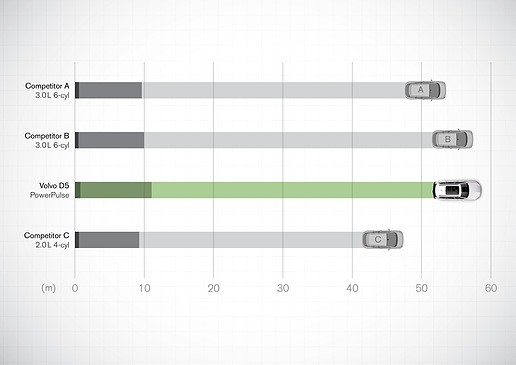 沃尔沃4缸D5柴油发动机采用的PowerPulse(图为压缩机和压力罐)系统重约10公斤,紧贴着安装在V90休旅车的头灯后方。
沃尔沃4缸D5柴油发动机采用的PowerPulse(图为压缩机和压力罐)系统重约10公斤,紧贴着安装在V90休旅车的头灯后方。 沃尔沃的PowerPulse系统可以利用压缩空气,推动柴油发动机的涡轮增压器从怠速状态开始加速运转。该系统也将使用在XC90及更多其它即将推出的车型上。
沃尔沃的PowerPulse系统可以利用压缩空气,推动柴油发动机的涡轮增压器从怠速状态开始加速运转。该系统也将使用在XC90及更多其它即将推出的车型上。 PowerPulse与友商产品Step-off性能的对比,沃尔沃并未透露友商的具体名称。
PowerPulse与友商产品Step-off性能的对比,沃尔沃并未透露友商的具体名称。 全新沃尔沃V90旅行车的尾部倾斜,给人一种赏心悦目的美感,但与之前版本相比,这种设计略微减少了车辆的储物空间。
全新沃尔沃V90旅行车的尾部倾斜,给人一种赏心悦目的美感,但与之前版本相比,这种设计略微减少了车辆的储物空间。 图为沃尔沃V90旅行车的车身结构材料构成。
图为沃尔沃V90旅行车的车身结构材料构成。
沃尔沃通过使用压缩空气,提高全新D5柴油发动机的扭矩,并消除“延迟”。沃尔沃的工程师驾驶一辆搭载D5发动机的V90休旅车,在西班牙南部进行了一段路程漫长,而且经常路况苛刻的试驾。事实上,正如沃尔沃的工程师在试驾中向《汽车工程杂志》所展示的那样,这种技术相对简单,但却非常高效。
沃尔沃将这款采用了大量专利技术的创新柴油送气系统称为“PowerPulse”,该技术可以替代搭配电驱动涡轮增压器或超级增压器的48V混动系统。系统能够在发动机转速较低时,迅速驱动涡轮转动,并且成本低廉。
为了研发PowerPulse,沃尔沃的动力总成工程师总共花了三年多的时间,这一技术的关键路径与D5发动机相同。据称,这款2.0升4缸直喷柴油发动机可以输出173 kW(232 hp)的动力和480N·m(354 lb·ft)的扭矩。此外,公司还有一款未采用PowerPulse技术的D4发动机。这款D4发动机功率较低,可以输出140 kW(188 hp)的动力和400N·m(295 lb·ft)的扭矩。
一个简单紧凑的系统
在行驶过程中,PowerPulse技术的作用非常明显,它可以协助V90休旅车实现7.2秒内由静止加速至100km/h (62 mph)。以V90的功率输出水平和1817kg(4006 lb)的整备质量来看,这样的表现还算敏捷,但称不上异常出色。V90休旅车采用了一款8速爱信(Aisin)自动变速器,没有手动挡版本。
沃尔沃动力总成项目经理Fredrik Ulmhage表示,PowerPulse完全是一款沃尔沃自主研发的产品。“其他公司都没有这种技术。”Ulmhage断言,“公司计划推广4缸柴油发动机(我们也有汽油发动机发展计划),但必须先解决涡轮延迟的问题,也就是在废气产生压强之前,先让涡轮转起来。”
Ulmhage解释说,“因此,简单来说,我们就是在驾驶员踩下油门的同时,将压缩空气推入车辆的排气歧管,涡轮在几毫秒之内就可以开始加速转动。”
这个过程可以连续进行2次,中间几乎没有停顿。但是,如果需要连续3次送气(这种可能性非常低),系统则需要几秒时间准备压缩空气。系统中存在一个小型压缩机,能够以12 bar(174 psi)的压强将空气挤进一个2.0L的气箱内,而系统的动作则由一个电磁阀控制。
沃尔沃D5发动机搭配了两个尺寸分别为38 mm和53 mm的博格华纳(BorgWarner)涡轮增压器,这两个增压器按顺序依次进行运转。据沃尔沃的工程师称,该系统可在0.3秒内从怠速状态加速至150,000 rpm的峰值转速。Ulmhage指出,“与其他友商的6缸柴油发动机相比,我们的新4缸发动机在最初50~60米都处领先地位。”他同时确认,沃尔沃 XC90 SUV将采用PowerPulse技术。此外,PowerPulse还有可能配备在更多新车型上。
PowerPulse系统重约10kg(22 lb),完全可以安装在位于发动机盖下的头灯底座后方。为了减轻压力罐的重量,沃尔沃的工程师正在研究各种可能使用在这里的轻质材料。
为了提高汽油发动机的能效,使之达到与柴油发动机类似的水平,沃尔沃开展了一系列以提升混合动力能效为重点的优先技术项目。
据悉,沃尔沃即将推出一款3缸汽油发动机,预计额定输出功率超过130 kW (174 hp)。这款发动机将配备在一些功率较小的沃尔沃车型上。与柴油机相比,这款3缸汽油发动机不仅可以带来出色的能效,而且成本也更低,原因在于为了达到排放标准,而不得不在柴油发动机上采用更多的发动机控制手段和后处理系统,而汽油发动机这方面的需求较低。
除了V90,沃尔沃还将推出一款新的汽油机车型——S90 T6轿车,这也体现了沃尔沃与梅赛德斯-奔驰(Mercedes-Benz)和奥迪(Audi)一决高下的决心。V90和S90 T6这两个车型均采用了沃尔沃的可扩展整车平台架构,XC90也是如此。
福特沃尔沃vs.吉利沃尔沃
沃尔沃的产品经理Lars Lagström表示,如今,沃尔沃已经拥有了一个可以满足汽车架构和底盘动力需求,带来一流驾乘体验的平台。现在,公司开始将目光转向NVH(噪声、振动和不平顺性)特性和其他细节的改善。Lagström将吉利沃尔沃和过去的福特沃尔沃进行了比较,他提到,福特掌管沃尔沃的时候永远都在“控制预算”,并且“对待所有事情都目光短浅”,Lagström还说:“福特永远也无法理解沃尔沃。”
沃尔沃开展了一系列重点研发项目,其中包括一款内部研发的独立后悬挂系统。正是凭借这款悬挂系统,V90才能轻松征服公路驾驶环境,甚至连一些极具挑战性的弯道也不在话下。除了悬挂,内饰设计也是沃尔沃的另一个亮点,这要得益于公司内饰设计副总裁Robin Page(他在2013年前服务于宾利)。当你坐进这辆新款柴油休旅车的那一刻,车辆的内饰设计一定会让你眼前一亮。V90可以提供560到1526 升的超大储物空间,但由于巧妙利用了地板下的位置,这款车的外形并未受到影响,仍然非常有型。V90的空气动力学性能表现也相当不错,车辆的风阻系数最低可达0.30 Cd。
随着自动驾驶技术的不断发展,沃尔沃V90和S90均具备领航辅助(Pilot Assist)功能和自适应巡航控制(Adaptive Cruise Control)功能。在有道路标记的车道内,这两款车可以在时速不超过130 km/ h (81 mph)的情况下,进行一系列半自动驾驶操作,包括转向、加速和制动。但值得注意的是,这还并不是一个全自动驾驶系统。

Volvo bets on new PowerPulse, not 48V, for turbodiesel boost assist
Volvo is using a blast of compressed air to boost torque delivery and exorcise turbo "lag" of its new D5 diesel engine. It's a comparatively simple technology solution that works very effectively, as company engineers demonstrated to Automotive Engineering on a lengthy and often demanding test drive of the D5-powered V90 station wagon in southern Spain.
Volvo has dubbed the novel, heavily patented diesel air-delivery system "PowerPulse." It serves as a cost-effective alternative to using a 48-V hybrid system with electrically-driven turbocharger or supercharger to rapidly spin up turbines at low engine revs.
Volvo powertrain engineers spent more than three years developing PowerPulse, on the same critical path as the D5 engine. The 2.0-L 4-cylinder direct injected diesel delivers a claimed 173 kW (232 hp) and 480 N·m (354 lb·ft). A lower-powered D4 version producing 140 kW (188 hp) and 400 N·m (295 lb·ft) without PowerPulse also is available.
A simple, compact system
On the road PowerPulse literally blows into action, helping the V90 wagon accelerate from standing start to 100 km/h (62 mph) in 7.2 s which, bearing in mind the car’s power output and 1817-kg (4006-lb) curb weight, is brisk but not exceptional. The car’s automatic transmission is an 8-speed Aisin. No manual gearbox is offered.
Powertrain Program Manager Fredrik Ulmhage said the PowerPulse system was conceived entirely in-house. “No one else has it," he asserted. "We have a 4-cylinder diesel strategy (as we have for our gasoline engines) and decided we needed to deal with any turbo lag, getting the turbo running before exhaust pressure built.
"So basically, we push compressed air into the exhaust manifold as the driver pushes the accelerator pedal and within milliseconds the turbo spools up,” Ulmhage explained.
This can happen twice consecutively, with virtually no pause between applications. If a third rapidly-required consecutive step-off is needed (regarded as an extremely rare likelihood), it would take a couple of seconds for the system to re-charge to provide a further pulse. A small compressor squeezes air into a 2.0 L tank at a pressure of 12 bar (174 psi), with a magnetic valve controlling the action phase of the system.
Volvo's D5 engine is configured with two BorgWarner turbo machines sized 38 mm and 53 mm, respectively and operating sequentially. Engineers claim the system reaches its peak 150,000 rpm from idle in 0.3 s. “When we matched the system against competitors’ 6-cylinder diesel engines from stationary, our new 4-cylinder was ahead of them for up to 50 to 60 meters,” noted Ulmhage. He confirmed that Volvo's XC90 SUV will also be offered with PowerPulse. And the system is likely to be fitted to other upcoming models.
The PowerPulse system adds about 10kg (22 lb) to the base diesel engine. It fits into a convenient underhood space behind a headlamp housing. Volvo engineers are investigating lightweight materials that could be used to reduce mass of the pressure tank.
Volvo has a series of high-priority technology programs with the emphasis on hybrid efficiency and is aiming to take gasoline powertrains much closer to diesel fuel consumption potential.
A 3-cylinder gasoline engine is in the pipeline with a rated output expected to exceed 130 kW (174 hp). It will be used to power smaller Volvo models, bringing not only performance efficiency but also reduced unit cost compared to diesels, the cost of which rises as more engine controls and aftertreatment are incorporated to meet emission regulations.
The V90 is joined by the new gasoline-engine S90 T6 sedan (http://articles.sae.org/14568/), paired as part of Volvo’s determined bid compete with Mercedes-Benz and Audi. Both vehicles are underpinned by the company’s Scalable Product Architecture (http://articles.sae.org/12739/), as is the XC90.
Contrasting Geely and Ford
Finally possessing a platform the delivers the structure and chassis dynamics necessary to deliver premium-class ride quality, Volvo development engineers are now focusing on NVH and other details, stated Product Manager Lars Lagström. He contrasted the company's Geely ownership to the years under Ford, when "there were always squeezed budgets" and "it was short-term everything." Ford, Lagström noted, "never understood Volvo."
Key initiatives have included in-house development of the independent rear suspension that helps the V90 deliver a poised ride on motorways or challenging curves. Interior design is another priority, with the impact of Vice President of Interior Design Robin Page (with Bentley until 2013) immediately evident when you step inside the new diesel wagon. It offers 560 to 1526 L (20 to 54 ft3) of maximum luggage volume including underfloor storage while avoiding any hint of utilitarian styling. Aerodynamics of the V90 models achieve a best of 0.30 Cd.
With the approach of the age of autonomous driving, the V90 and S90 offer Pilot Assist and adaptive cruise control, which team to provide semi-autonomous operation of steering, accelerator and brakes within lane markings at speeds up to 130 km/ h (81 mph). But it is not a fully hands-off system.
Author: Stuart Birch
Source: SAE Automotive Engineering Magazine
等级
打分
- 2分
- 4分
- 6分
- 8分
- 10分
平均分
